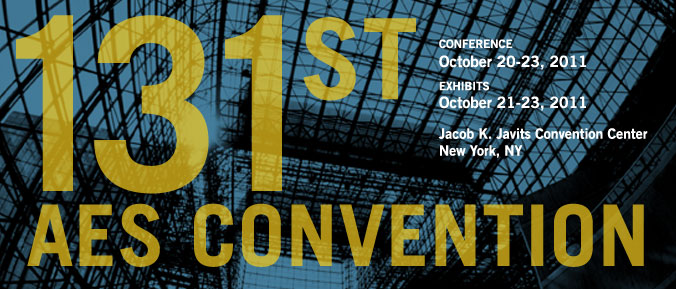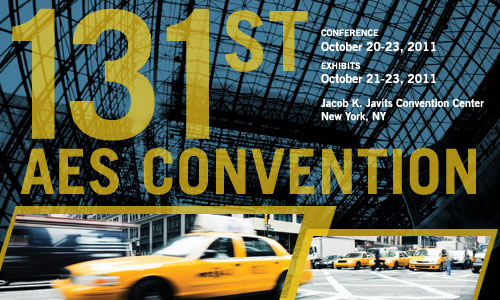
AES New York 2011
Poster Session P3
P3 - Transducers
Thursday, October 20, 10:00 am — 11:30 am (Room: 1E Foyer)
P3-1 Inter- and Intra-Individual Variability in Blocked Auditory Canal Transfer Functions of Three Circum-Aural Headphones—Florian Völk, AG Technische Akustik, MMK, Technische Universität München - Munich, Germany
In headphone playback, different factors contribute to a deviation of the presented from the intended stimuli. Most important are the headphone transfer functions, their inter-individual differences, and the intra-individual variability due to repeated positioning on the subjects’ heads. This paper gives a detailed inspection of the blocked auditory canal transfer characteristics for one specimen of each of three different circum-aural headphone models frequently used in psychoacoustics, two operating on the electro-dynamic, one on the electro-static converter principle. It is shown that the variability can have considerable influence on the stimuli presented, especially in the frequency range above 6 kHz. The data indicate headphone specific variability, suggesting the need for the variability to be considered as headphone selection criterion.
Convention Paper 8465 (Purchase now)
P3-2 Cable Matters: Instrument Cables Affect the Frequency Response of Electric Guitars—Rafael Cauduro Dias de Paiva, Aalto University School of Electrical Engineering - Espoo, Finland, Nokia Technology Institute INdT, Brasilia, Brazil; Henri Penttinen, Aalto University School of Electrical Engineering - Espoo, Finland
This paper presents analysis results of the effects an instrument cable has on the timbre of an electric guitar. In typical, well-designed audio equipment with proper impedance buffers, the effect of the cable can be considered insignificant at audio frequencies. In contrast, magnetic pickups used in electric guitars, act as resonating low-pass filters. The cable is attached to a resonating electrical circuit and hence its impedance characteristics can influence the system. The simulation and measurement results show that the capacitance of an instrument cable affects the frequency response of the system, whereas the effects of the inductance and series or parallel resistance are negligible. The largest shift in the resonant frequency for the measured cables was 1.4 kHz.
Convention Paper 8466 (Purchase now)
P3-3 An Approach to Small Size Direct Radiation Transducers with High SPL—Jose Martinez, Acústica Beyma, S.L. - Valencia, Spain; Enrique Segovia, Obras Públicas e Infraestructura Urbana - Alicante, Spain; Jaime Ramis, Ingeniería de Sistemas y Teoria de la Señal - San Vicent del Raspeig, Spain; Alejandro Espí, Acústica Beyma, S.L. - Valencia, Spain; Jesús Carbajo, Ingeniería de Sistemas y Teoria de la Señal - San Vicent del Raspeig, Spain
This work analyses some of the issues related to small size direct radiation loudspeakers design and aims to achieve high SPL using this kind of loudspeaker. In order to reach it, large diaphragm displacements are needed. Structural dynamic behavior of the moving assembly must be emphasized. With the aid of a numerical model implemented with finite elements, it is possible to quantify the influence of changing the number of folds in the suspension (spider), the distance between spiders, and the effect of unbalanced forces inherent to the loudspeaker construction. Numerical model predictions are compared with experimental results having as reference a six-inch loudspeaker development.
Convention Paper 8467 (Purchase now)
P3-4 High-Order Analog Control of a Clocked Class-D Audio Amplifier with Global Feedback Using Z-Domain Methods—Pieter Kemp, Toit Mouton, University of Stellenbosch - Matieland, South Africa; Bruno Putzeys, Hypex Electronics B.V. - Groningen, The Netherlands
The design of a clocked analog controlled pulse-width modulated class-D audio amplifier with global negative feedback is presented. The analog control loop is designed in the z-domain by modeling the comparator as a sampling operation. A method is presented to improve clip recovery and ensure stability during over-modulation. Loop gain is shaped to provide a high gain across the audio band, and ripple compensation is implemented to minimize the negative effect of ripple feedback. Experimental results are presented.
Convention Paper 8468 (Purchase now)
P3-5 A Novel Sharp Beam-Forming Flat Panel Loudspeaker Using Digitally Driven Speaker System—Mitsuhiro Iwaide, Akira Yasuda, Daigo Kuniyoshi, Kazuyuki Yokota, Moriyasu, Yugo, Kenji Sakuta, Fumiaki Nakashima, Masayuki, Yashiro, Michitaka Yoshino, Hosei University - Koganei, Tokyo, Japan
In this paper we propose a beam-forming speaker based on a digitally direct driven speaker system (digital-SP); the proposed speaker employs multi-bit delta-sigma modulation in addition to a line speaker array with flat-panel-loudspeakers (FPLS) and a delay circuit. The proposed speaker can be realized only by D flip-flops and digital-SP. The sound direction can easily be controlled digitally. All processes can be performed digitally without the use of analog components such as power amplifiers, and a small, light, thin, high-quality beam-forming speaker system can be realized. The prototype is constructed using an FPGA, CMOS drivers, and a line FPLS array. The 20 dB attenuation for 20 degree direction is measured.
Convention Paper 8469 (Purchase now)
P3-6 The Influence of the Directional Radiation Performance of the Individual Speaker Modules, and Overall Array, on the Tonal Balance, Quality and Consistency of Sound Reinforcement Systems—Akira Mochimaru, Paul Fidlin, Soichiro Hayashi, Kevin Manzolini, Bose Corporation - Framingham, MA, USA
Room acoustic characteristics, such as reflections and reverberation, often change the performance of speaker systems in a room. It has always been challenging to maintain the tonal balance of a single speaker module when multiple modules are used to form speaker arrays. Both phenomena are unique to sound reinforcement speakers and are mainly determined by a combination of the radiation characteristics of an individual speaker module and the interactions between modules, known as arrayability. First, this study reviews the performance of conventional speaker systems. Next, the acoustic characteristics of speaker modules desired for forming an ideal speaker array are discussed. A new category of speaker system, the Progressive Directivity Array, is introduced to realize the theory as a practical solution.
Convention Paper 8470 (Purchase now)
Information Last Updated: 20111005, mei

